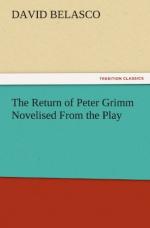Thus, no manager is more ingenious, more resourceful than David Belasco. But his care for detail is often a danger; he does not know fully the value of elimination; the eye of the observer is often worried by the multiplicity of detail, where reticence would have been more quickly effective. This is the Oriental in Belasco. His is a strange blend of realism and decorativeness.
“A young man came to me once,” he said to me, “with the manuscript of a new play, which had possibilities in it. But after I had talked with him awhile, I found him preaching the doctrines of the ‘new’ art. So I said to him, ’My dear sir, here is your manuscript. The first scene calls for a tenement-house set. How would you mount it?’”
He smiled, maybe at the recollection of Gordon Craig’s statements that “actuality, accuracy of detail, are useless on the stage,” and that “all is a matter of proportion and nothing to do with actuality.”
“I felt,” Mr. Belasco continued, “that the young man would find difficulty in reconciling the nebulous perspectives of Mr. Craig with the squalor of a city block. I said to him, ’I have been producing for many years, and I have mounted various plays calling for differing atmospheres. I don’t want to destroy your ideals regarding the ‘new art’, but I want you to realize that a manager has to conform his taste to the material he has in hand. I consider that one of the most truthful sets I have ever had on the stage was the one for the second act of Eugene Walter’s ‘The Easiest Way’. A boarding-house room on the top floor cannot be treated in any other way than as a boarding-house room. And should I take liberties with what we know for a fact exists in New York, on Seventh Avenue, just off Broadway, then I am a bad producer and do not know my business. I do not say there is no suggestion in realism; it is unwise to clutter the stage with needless detail. But we cannot idealize a little sordid ice-box where a working girl keeps her miserable supper; we cannot symbolize a broken jug standing in a wash-basin of loud design. Those are the necessary evils of a boarding-house, and I must be true to them’.”




